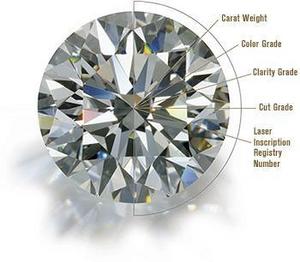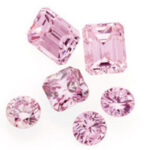The Gemological Institute of America (GIA) is an authority on diamonds. Diamonds usually come with a GIA rating. If your diamond isn’t rated, your jeweler can arrange with the GIA to have it done. The rating is given upon a certified examination according to four parameters: color, clarity, carat weight, and cut. Here’s what each of those characteristics mean, how they’re rated, and the effect they have on value.
Color
The GIA’s color rating scale for white diamonds goes from D to Z, with D representing the best rating possible for a diamond with no color. White diamonds usually fall within the range from D to K with little detectable color. After K, the diamond begins to look yellow.
The value of the diamond tends to decrease the farther it is down the alphabet. Despite all of the possible ratings from D to Z, the color differential from one letter to the next is nearly invisible to the untrained eye. Very small differences occur from one grade to the next.
Clarity
Diamonds come with inclusions, or tiny crystals of another material included in the clear diamond. They range from a few to a lot in any diamond. For a diamond to have no inclusions is rare. These are rated FL for flawless. The fewer the inclusions, the more valuable the diamond is.
There are eleven clarity ratings ranging from flawless to many observable inclusions, with decreasing diamond value, as follows:
FL (flawless)
IF (internally flawless)
VVS1 (very very slightly included)
VVS2
VS1 (very slightly included)
VS2
S1 (slightly included)
S2
I1 (included)
I2
I3
Carat weight
Not to be confused with karats (for karat gold such as 10k, 14k, 18k, or 24k gold), the carat is a weight measurement for diamonds equaling 0.2 grams or 1/142 of an ounce.
A carat is divided into points. There are 100 points in one carat. So, half a carat is 0.5 carat, with fractional carats expressed in decimals.
The value of a diamond goes up with its carat weight, all other things being equal, which they’re usually not. Bigger may not be better, but when it comes to diamonds, bigger usually costs more than small.
Cut
The standard cut for diamonds is the round brilliant cut. It has 58 facets, the standard number bringing out the diamond’s maximum brilliance. The brilliant cut reflects light from the crown, rather than through the sides or the bottom of the diamond.
Other cuts include emerald, pear, oval, and marquise. Their brilliance may be compromised by diminished dispersion of light from the diamond. We buy diamonds for their sparkle and shine, which are maximized in the brilliant round cut.
Your diamonds
When you know the GIA ratings of a diamond, you are better positioned to know its value. When you know the GIA ratings of your diamonds, you will value them more.
Source: www.gia.edu/



